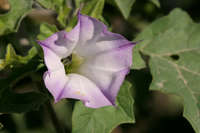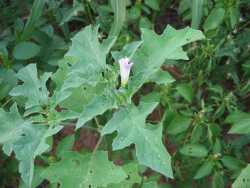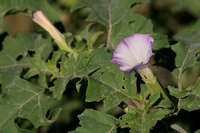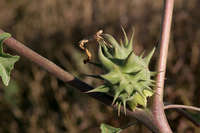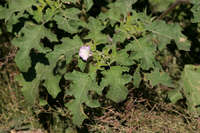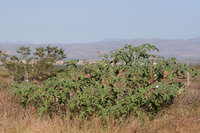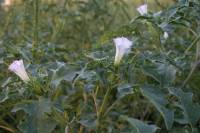Plant: Annual herb; glabrate to pubescent, with a short, weak tap root
Leaves: ovate, 6-16 cm long, 3-6 cm wide, the upper surfce glabrescent, the lower surface pubescent (usually along veins), acute, pinnately lobed, the lobes often toothed; base cuneate to subcordate; petioles sometimes as long as or longer than blade
Flowers: with calyx 1.5-4 cm long, the teeth acute to acuminate, 2-6 mm long; corolla white, light violet to purple, the tube 3.8-7.7 cm long, the limb 1-2 cm wide, the acumens acuminate, 1-3 mm long
Fruit: FRUITS erect, dehiscing along 4 sutures to base, green, ovoid to ellipsoid, 3-4.5 cm long, with 100-300 spines, the terminal spines 2-3.5 mm long, the other spines 0.5-1.5 mm long; pericarp glabrate to puberulent; persistent calyx base reflexed; SEEDS reniform to discoid, 3-4.5 mm long, 2.5-3.5 mm wide, rugose
Misc: Roadsides and waste grounds; 1200-1850 m (4000-6000 ft); May-Oct
REFERENCES: Bye, Robert. 2001. Solanaceae. JJ. Ariz. - Nev. Acad. Sci. Volume 33(1).
Duration: Annual
Nativity: Native
Lifeform: Forb/Herb
General: Bushy annual herbs, to 1.5 m tall, from a short, weak taproot; stems erect to ascending, branching throughout; herbage glabrate to pubescent, with younger growth usually downy or pubescent.
Leaves: Alternate along the stems, on petioles often as long as the leaf blade; blades ovate in outline, 6-16 cm long and 3-6 cm wide, with pinnately lobed margins, the lobes often toothed; upper leaf surface glabrescent and lower surface pubescent (usually along veins).
Flowers: Large, showy, and purplish; solitary in leaf axils and at tips of stems, on shory pedicels; calyx cylindrical, about half the length of the corolla, tipped with 5 short triangular teeth; corolla funnel-shaped, 4-7 cm long, creamy white or light violet to purple.
Fruits: Capsules erect (upward-pointing), ovoid, 3-4 cm long, covered with relatively few stout spines of unequal lengths, with the larger spines greater than 1 cm long; capsule splits open along 4 longitudinal sutures to release large flat, dark-colored seeds.
Ecology: Found on roadsides and waste grounds, from 4,000-7,000 ft (1219-2134 m); flowering May-October.
Distribution: TX to s AZ; south to MEX
Notes: Most sources list this large bushy herb as an annual, but Flora of New Mexico (Martin and Hutchins 1980) lists it as annual to perennial. Distinguish from other Datura spp. based on its relatively small purple-tinged flowers, 4-7 cm long; the erect oval-shaped seed pods, which have relatively few spines of varying lengths; and the leaves which are pinnately lobed and superficially resemble oak leaves.
Ethnobotany: Highly toxic and poisonous; used ceremonially as a hallucinogen.
Etymology: Datura comes from Dhatura, the Hindustani name for the plant; quercifolia means oak-leaf, from the oak genus Quercus.
Synonyms: Datura ferox
Editor: LCrumbacher 2012, FSCoburn 2015, AHazelton 2017



